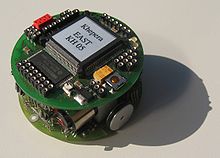Khepera mobile robot


The Khepera is a small (5.5 cm) differential wheeled mobile robot that was developed at the LAMI laboratory of Professor Jean-Daniel Nicoud at EPFL (Lausanne, Switzerland) in the mid 1990s. It was developed by Edo. Franzi, Francesco Mondada, André Guignard and others.
Small, fast, and architectured around a Motorola 68331, it has served researchers for 10 years, widely used by over 500 universities[citation needed] worldwide.
Scientific impact
The Khepera was sold to a thousand research labs and featured on the cover of the 31 August 2000 issue of Nature.[1][full citation needed] It appeared again in a 2003 article.[2]
The Khepera helped in the emergence of evolutionary robotics.[citation needed]
Technical details
Original version
- Diameter: 55 mm
- Height: 30 mm
- Empty weight: 80 g
- Speed: 0.02 to 1.0 m/s
- Autonomy: 45 minutes moving
- Motorola 68331 CPU @ 16 MHz
- 256 KB RAM
- 512 KB EEPROM
- Running μKOS RTOS
- 2 DC brushed servo motors with incremental encoders
- 8 infrared proximity and ambient light sensors (SFH900)
2.0 Version
- Motorola 68331 CPU @ 25 MHz
- 512 KB RAM
- 512 KB Flash
- Improved batteries and sensors
3.0 Version
- 800 MHz ARM Cortex-A8 Processor
- Weight: 540g
- 256 MB RAM
- 512 MB plus additional 8GB for data
- Battery: 7.4V Lithium Polymer, 3400mAh
Extensions
Several extension turrets exist for the Khepera, including:
- Gripper
- 1D or 2D camera, wire or wireless
- Radio emitter/receiver, low and high speed
- I/0
See also
Webots – software that simulates and allows cross-compilation and remote control of the Khepera and other robots
References
- ^ "Volume 406 Issue 6799, 31 August 2000". nature.com. 31 August 2000. Retrieved 14 July 2021.
- ^ Verschure, Paul F. M. J.; Voegtlin, Thomas; Douglas, Rodney J. (October 2003). "Environmentally mediated synergy between perception and behaviour in mobile robots". Nature. 425 (6958): 620–624. Bibcode:2003Natur.425..620V. doi:10.1038/nature02024. ISSN 1476-4687. PMID 14534588. S2CID 4418697.
- Notes
- Mondada, F., Franzi, E., Guignard, A. (1999), The Development of Khepera. In proceedings of First International Khepera Workshop, Paderborn, 10–11 December 1999. PDF BibTex Archived 6 July 2011 at the Wayback Machine EPFL Infoscience entry
External links
- Homepage – K-Team, the company which sells the Khepera robots
